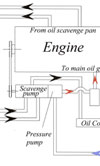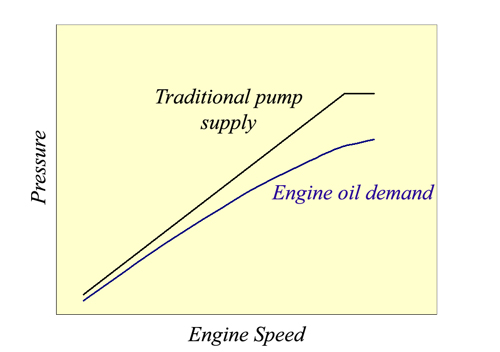Variable flow oil pumps
 The science of engine development is one of incremental steps; small but measurable increases in power over a period of time. Improvements in port flow, increasing the engine rev limit or changes in intake or exhaust system sizes will, no doubt, help. But while that is undoubtedly the high profile, glamorous part of development, as far as engine performance goes, it is only half the story. The other, perhaps less glamorous part is that of minimising the parasitic losses; the friction in all the sliding components and the power to drive all the auxiliary drive systems - which includes of course, the oil pump.
The science of engine development is one of incremental steps; small but measurable increases in power over a period of time. Improvements in port flow, increasing the engine rev limit or changes in intake or exhaust system sizes will, no doubt, help. But while that is undoubtedly the high profile, glamorous part of development, as far as engine performance goes, it is only half the story. The other, perhaps less glamorous part is that of minimising the parasitic losses; the friction in all the sliding components and the power to drive all the auxiliary drive systems - which includes of course, the oil pump.
In earlier articles we have established that oil pumps are invariably of the positive displacement type and it therefore follows that the power needed to drive them will be proportional to the volume flow rate produced and hence the engine speed. This flow rate will also vary with the temperature (and hence viscosity) of the oil and the clearances in the bearings but essentially for a given temperature the power consumed by the pump increases more or less linearly with speed. Traditionally the size of the oil pump is based around the flow requirement of the bearings at or near the engine idling speed. At this condition, classical bearing analysis assumes that the void between the journal and bearing will run full of oil but that any leakage from the sides will be made up by the flow from the oil pump.

As the speed increases most oil pumps therefore will be sized and have sufficient capacity to more than make up for the increasing leakage losses until the pressure reaches a certain pre-set value. At this point any further oil pumped will be directed back to the sump via the pressure relief valve. And while the output of the pump rises in proportion to the engine speed the demand from the engine bearing system does not. This additional pressure over and above that needed at the bearings therefore causes unnecessary extra pumping work. If we could tailor this output to that closer to the bearing requirement then pumping efficiency could increase and energy savings could be made.
The lube system in a modern engine can consume somewhere around 3-5% of the overall engine power output. Since these powers can be relatively small (a matter of a few bhp) and the complexity of producing a reliable variable flow pump onerous, manufacturers have often kept to the traditional approach of a simple pump and pressure relief valve. However as continuing improvements in fuel economy or performance becomes more difficult, the need to match the flow output of the pump with the demands of the engine assumes a higher level of importance.
One way of achieving this could be by using an electrically operated independent oil pump. While these have been suggested, I am not aware of anyone save on some kind of research engine who has as yet taken up this approach. Another way more recently introduced into the world of heavy-duty diesels is the split gerotor principle. Flow variation is achieved by dividing the rotor set in two along it’s axis and altering the radial position of the offset (the difference between the centres of the inner and outer rotors) of each of them but in the opposite direction. Much more complicated than the traditional approach, in this way however, the actual displacement can be varied to suit the demands of the engine.
Written by John Coxon.